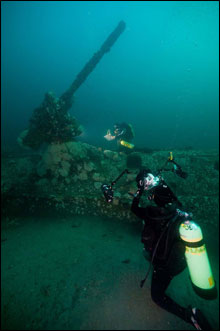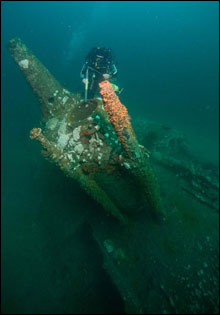Mission Log: Aug. 22, 2009
By Brett SeymourA/V Production Specialist/Diver
National Park Service Submerged Resources Center
Boats and weather - they are a constant battle for anyone who makes their living on (or under) the water. Just as the flotilla of project boats are back on-line, Hurricane Bill skirts up the Eastern seaboard. The Battlefield of the Atlantic crew can only watch the 12-15ft swells make landfall on Atlantic Beach over lunch on Saturday.
As the waves roll in, it gives the team a couple days to catch up on the data wrangling that accompanies any given project. Plotting field drawings on the site map, a much needed wash of the dive gear, and in my case, time to work up the hundreds of images that are generated during each day. My latest batch of photographs was generated on the U-85 late last week. Although Dave Conlin and I had the opportunity to dive the site earlier in the project, on this trip we would be working with one of the greats in underwater photography, David Doubilet.
 |
| Dave Conlin (NPS) collects data on the U-85, while National Geographic Magazine Photographer, David Doubilet, takes photos. (Photo: Courtesy of Seymour/NPS/NOAA) |
I first met David back in back in 2000 on the USSArizona, while the National Park Service Submerged Resources Center was conducting a corrosion study on the 608’ submerged battleship. He was brought in to shoot for an article on the 60th anniversary of the Pearl Harbor attack for National Geographic Magazine. The story examined the current condition of the American icon and the stewardship responsibilities of the National Park Service. For a young underwater photographer eager to learn from the best, the experience was invaluable. There, as with the U-85, his eye for the dramatic was unmistakable and his laidback, yet disciplined approach to creating an image was refreshing.
We met up with David and Jen at the dock and helped them load a small fortune in underwater still cameras and lights. The hour transit to the site gave us the opportunity to catch up and plan what David wanted out of the shoot. During the previous week’s dive, I had created a photo mosaic of the German U-boat, which helped us plan the dive. Immediately David’s finger went to the forward deck gun as the shot. Agreed, I thought to myself. Not placing myself in the same league as David, seeing the shot and creating it are two very different things.
Conlin and I had some project related tasks for the dive, which including lowering a YSI environmental sonde into the open hatches of the U-boat. This instrument collects environmental data about things like dissolved oxygen, pH, salinity, and temperature that will feed into corrosion studies. As we were diving closed circuit rebreathers, our bottom time was easily double the time of David and Jen on standard SCUBA cylinders, so we splashed first.
 |
| Dave Conlin (NPS) surveys the conning tower of the U-85. (Photo: Courtesy of Seymour/NPS/NOAA) |
A quick check of my rebreather, depth and time and we were off to the stern to place the YSI. We met up with David and Jen 30 minutes into our dive just as planned. Conlin’s task was to accept cryptic hand gestures that are randomly thrown out by underwater photographers when we need the “talent” to move up, over, or simply stay. His years deciphering my hand rants had paid off as he was easily able to comprehend David’s cues. I spent the dive hovering behind David shooting stills while Jen crouched behind the deck gun and lit Conlin with underwater lights.
To be honest, I’m not really sure what I expected watching David shoot underwater. After years of admiring his work, I guess magical rays of sunlight at his beck and call or the ability to usher in a pod of bottlenose dolphin to serve as a backdrop would not have surprised me (none of which happened by the way). What I did see was a professional working to get the shot. It occurred to me “that’s the key.” Work. Rarely do the portfolio shots simply come along. Most take work and working underwater is not easy. And it doesn’t matter if you are David Doubilet, an underwater shooter with the NPS or an aspiring photographer with a point and shoot camera. I have always maintained that taking a picture underwater is not difficult in our digital world. Creating an image takes discipline and work. For the remainder of the dive and some of second descent to the U-85, we worked with David to create the shot. I have no way of knowing if the U-boat images will ever see publication, but for me, personally, it was a great day to catch up with fellow underwater photographers, talk f-stops and megapixels, and reaffirm that difference between the best and the rest is two things– discipline and work.



No comments:
Post a Comment